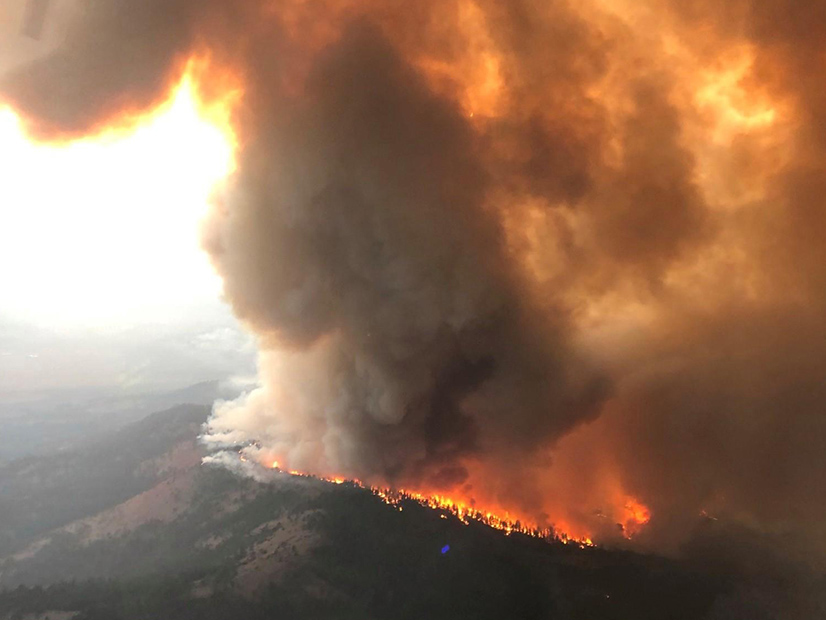
The California Department of Forestry and Fire Protection said last week it found that a tree falling onto a PG&E distribution line last July ignited the nearly 963,000-acre Dixie Fire, the second largest in state history, which destroyed more than 1,300 structures and killed one person.
“The Dixie Fire investigative report has been forwarded to the Butte County District Attorney’s Office” for possible criminal prosecution, Cal Fire said in a Jan. 4 news release.
Butte County prosecutors won 85 felony convictions against PG&E for starting the devastating Camp Fire in November 2018, killing 84 residents, and now are leading a coalition of five counties investigating PG&E’s role in the Dixie Fire.
The finding that PG&E started the wildfire was not a surprise; PG&E said soon after the blaze began that its line may have ignited the blaze. (See PG&E Expects $1B in Costs from Dixie Fire.)
“As we shared in our public statement in Chico in July after the start of the Dixie Fire, a large tree struck one of our normally operating lines,” PG&E said in a statement following Cal Fire’s announcement on Jan. 4. “This tree was one of more than 8 million trees within strike distance to PG&E lines.”
“Taking a bold step forward, PG&E has committed to burying 10,000 miles of lines in addition to the mitigations included in PG&E’s 2021 Wildfire Mitigation Plan,” the utility said. “Regardless of today’s finding, we will continue to be tenacious in our efforts to stop fire ignitions from our equipment and to ensure that everyone and everything is always safe.”
Last year, prosecutors in Sonoma and Shasta counties charged PG&E in the 2019 Kincade Fire and the 2020 Zogg fire. Cal Fire determined a tree that fell on a PG&E line started the Zogg Fire. The cause of the Kincade Fire remains under investigation.
PG&E acknowledged its lines likely started both fires but denied it was criminally liable for either blaze.
Federal prosecutors on Thursday said they would not ask for an extension of PG&E’s probation time based on California criminal charges. (See Judge Refrains from Adding Time to PG&E Probation.)
Monitor Findings
In November, the independent monitor appointed by the court to oversee PG&E during its probation said the utility needs to make substantial improvements in its efforts to prevent wildfires through vegetation management and grid hardening.
“Multiple years of horrific wildfires” started by PG&E equipment showed “its progress regarding wildfire mitigation obviously has been inadequate, and we doubt anyone would seriously dispute that, given the ongoing and profound safety issues in that area of operations,” the law firm Kirkland & Ellis, which the court appointed monitor, wrote in its report to Alsup.
“Including the Camp Fire fatalities, over 110 people have died as a result of wildfires where Cal Fire has determined PG&E equipment was involved since the San Bruno incident,” which killed 8 people, the monitor wrote.
Its reviews of PG&E safety practices showed the utility probably has missed tens of thousands of dangerous trees near its lines and failed to detect worn or broken equipment in many situations. PG&E still has a vast backlog of problems to fix from a 2019 inspection of 685,000 distribution poles, 50,000 transmission structures and 200 substations in high-fire threat districts, the monitor noted.
“There are over 500,000 tags from 2019 to present that remain unresolved to date,” it said.
The monitor also expressed skepticism about PG&E’s plans to bury 10,000 miles of power lines in fire-prone areas. CEO Patti Poppe announced the effort in July during the same media event in which she discussed the utility’s possible role in starting the Dixie Fire. (See PG&E Proposes Undergrounding 10K Miles of Distribution.)
“The monitor team applauds PG&E’s commitment to undergrounding to mitigate wildfire risk but notes that some serious questions and issues remain regarding PG&E’s implementation of the undergrounding initiative,” it said.
The utility did not give a time frame for the work but has plans to underground just 66 miles of lines in this year and a total of 327 miles over the next three years, the monitor said.
Even if it greatly increases its efforts over a 20-year period, “there is substantial skepticism among PG&E field personnel that PG&E can feasibly underground more than 500 miles per year using current technology and hardening methodologies,” the monitor said.

